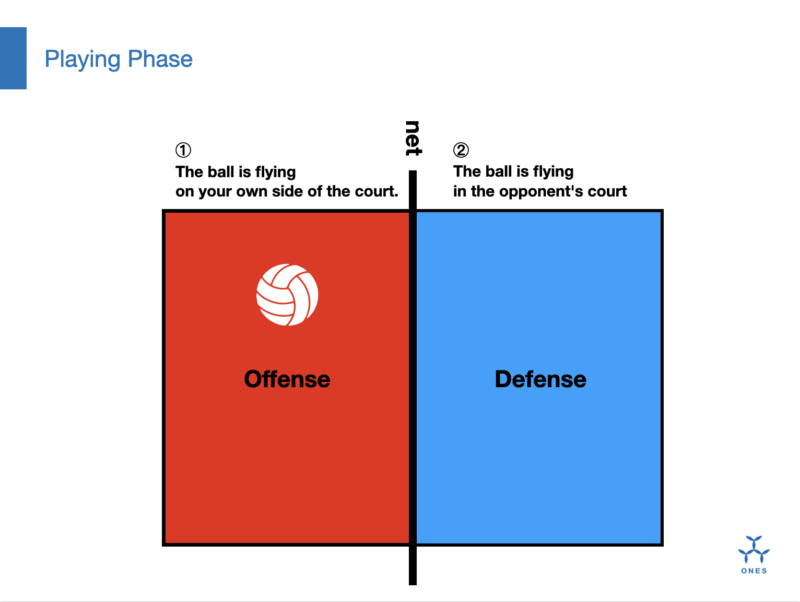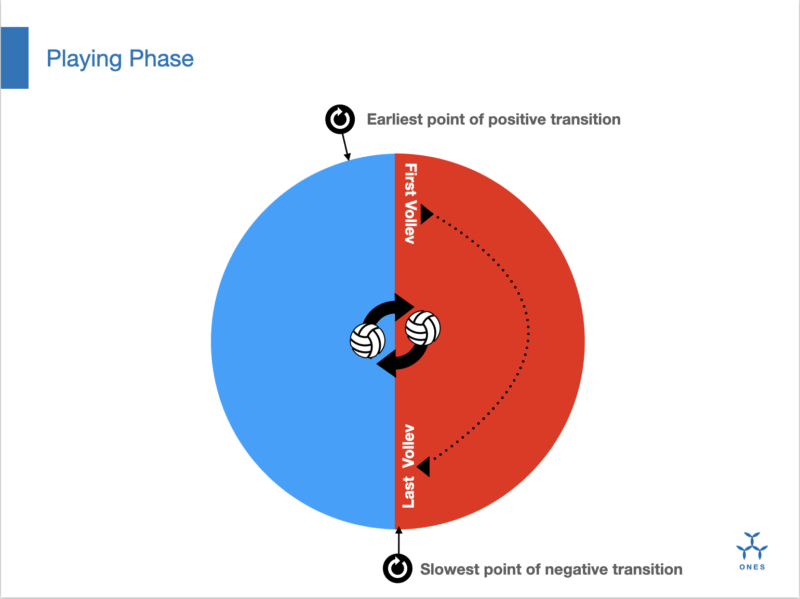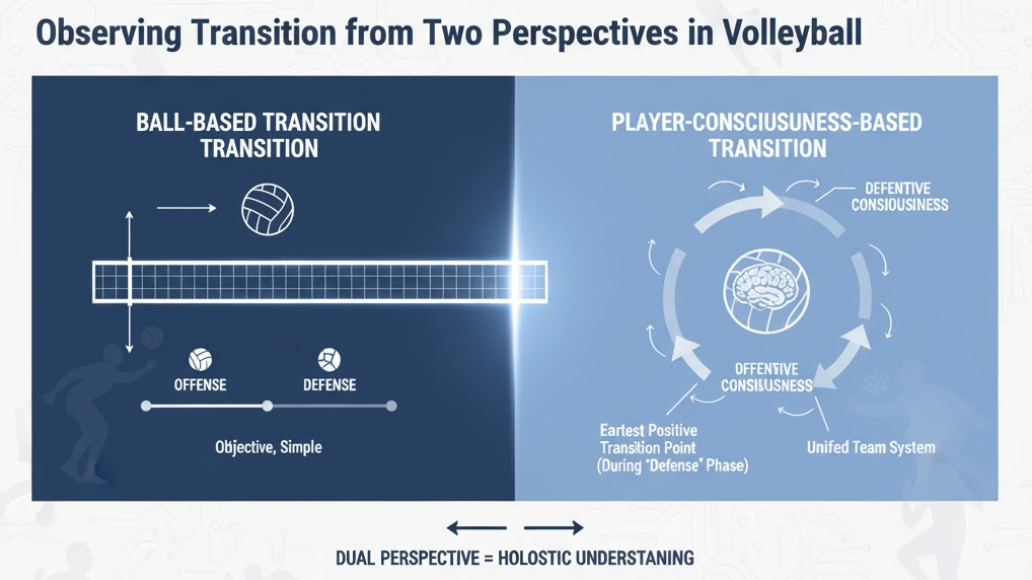One characteristic of volleyball is the act of volleying the ball across a net.
Naturally, players cannot cross the net; only the ball is permitted to traverse this boundary. This volleying action, where the ball repeatedly crosses the net, is what defines the game.
Players seek to score with powerful volleys (offense) and, in response, attempt to prevent the ball from dropping onto their court by volleying it back (defense). This dynamic rally (the back-and-forth struggle of offense and defense) is arguably the greatest appeal of volleyball.
While I may have waxed poetic about the charm of volleyball, the core purpose of this article is to observe the essence of the “thing” that exists in the gap between offense and defense to increase our understanding of this central dynamic.
Transition in the Gap Between Offense and Defense
Before focusing on volleyball, let’s broaden our view to consider the offensive and defensive dynamics in ball games generally.
While offense and defense exist in most ball sports, the nature of their transition can be categorized into three patterns:
- Transition is clearly defined by the rules (Baseball, American Football).
- Transition is chaotic (Basketball, Soccer/Football).
- Transition is both ordered (Cosmos) and chaotic (Volleyball, Tennis).
Let’s elaborate on each one.
1. Transition Clearly Defined by Rules
Take Baseball as an example. The start determines who is batting first (offense) and who is fielding (defense). When a team is on offense, they focus entirely on offense; when on defense, they focus entirely on defense. The transition occurs explicitly with the phrase, “Three outs, switch!”
It is perfectly clear to everyone when the shift from offense to defense happens.
2. Chaotic Transition
Now consider Soccer. It’s helpful to compare it with volleyball. Soccer has no net; there is nothing physically separating the opposing sides as there is in volleyball. Therefore, it is difficult to clearly determine offense and defense based on which side of the court the ball is on (i.e., which team is in a position to control the ball).
To judge offense or defense, one typically looks at possession of the ball: the team with possession is on offense, and the team without is on defense. However, there are moments when neither team possesses the ball, making even this determination difficult.
Furthermore, a pass intended for a teammate might be intercepted by an opponent, causing an unexpected and instantaneous switch between offense and defense. When viewed from the perspective of the ball’s movement, the transition between offense and defense in soccer is highly chaotic (disordered).
3. Transition: Both Ordered and Chaotic
Finally, let’s look at Volleyball.
The transition between offense and defense is closer to the latter example (soccer) than the former (baseball), as there is no clear “first offense” or “second offense” dictated by the rules.
However, it’s not exactly like soccer due to the crucial presence of the net. The net prevents players from intermingling, and only the ball can cross it.
In volleyball, a team can control the ball while it’s floating above their court. Once the ball crosses the net, control is impossible without supernatural intervention.
Therefore, if we focus solely on the ball’s movement, the transition between offense and defense appears simple and clearly definable: it happens when the ball crosses the net. It seems less complex than in net-less sports like soccer.
However, to truly grasp the essence of the offense-defense transition, focusing only on the ball’s movement may be insufficient. To profoundly understand the transition, we must first define: What is offense, and what is defense?
One might easily answer this question by observing the play name (e.g., Attack or Receive). But these terms are merely objective labels used for discussion and description. To put it boldly, they only name the observable phenomenon of the play.
The essential answer to the question, “Is this offense or defense?” is known only to the player who executed the play—it is a matter of the player’s consciousness or intent.
Consider a specific example: A player might appear to be spiking the ball (look like offense), but their internal consciousness is not aggressive (they are merely playing the ball safely back to the opponent’s side). Conversely, a defender might anticipate a weak attack and be mentally preparing for an offensive setup even before receiving the ball.
If we look beyond the play’s name and focus on the player’s consciousness, will, and intent, objectively defining which play is offense, which is defense, and precisely where the transition occurs becomes extremely difficult.
Observing Transition from Two Perspectives
The discussion may have become complex, so let’s consolidate our understanding of the transition in volleyball, utilizing the points discussed above.
To grasp the essence of any phenomenon, it’s crucial to observe it from multiple perspectives rather than a single viewpoint. Here, we will analyze the transition from two perspectives:
- Ball-Based Transition
- Player-Consciousness-Based Transition
1. Ball-Based Transition
Consider the following diagram, which represents the phases of a volleyball rally in the simplest way possible:

The team with the ball flying over its court is in the Offensive Phase. The opposite team is in the Defensive Phase. This is a simple, objective understanding accessible to anyone.
Where does the transition exist from the ball’s perspective?
The answer is: the instant the ball crosses the net—a single moment. In the diagram, the boundary is represented by the net. The moment the ball crosses this boundary is the transition. The advantage of the Ball-Based Transition perspective is its extreme simplicity.
2. Player-Consciousness-Based Transition
The Ball-Based Transition is straightforward; the net is an easily identifiable transition point. We must not forget the importance of this objective, shareable viewpoint.
However, to capture the essence of the transition, we must deeply examine the Player-Consciousness-Based Transition. Unlike the Ball-Based perspective, this is difficult to judge objectively, share, or even easily conceptualize. Nevertheless, I will do my best to explain it.
Please look at the next figure:

This figure represents the player’s consciousness—their internal state. The blue section corresponds to the Defensive Phase (Ball-Based), and the red section to the Offensive Phase (Ball-Based). This color coding merely indicates whether the ball is over the opponent’s or your own court (a benefit of observing one event from multiple perspectives).
Let’s clarify the labels: “First Volley” denotes the first touch, and “Last Volley” denotes the last touch (used because the rules permit returning the ball in fewer than three contacts).
Next, “Positive Transition” refers to the instant the player’s consciousness shifts from defense to offense. “Negative Transition” is the reverse: the shift from offense to defense.
Now that we have established a shared understanding, we can finally delve into the Player-Consciousness-Based Transition.
Positive Transition
The question here is: At what moment does the player’s consciousness shift from defensive to offensive?
Think back to various plays you’ve experienced or observed.
The simple answer is: There are as many answers as there are players.
Imagine the opponent’s hitter executing a weak, “half-attack” third touch.
- Player A on your team judges the attack as a free ball and immediately starts moving to prepare for an approach jump (offensive consciousness). For Player A, a Positive Transition has occurred, even though the Ball-Based Transition still indicates a Defensive Phase.
- Player B on your team perceives the play as a genuine attack (feeling attacked) and is focused solely on positioning to execute a good dig (defensive consciousness). For Player B, the Positive Transition has not yet occurred.
This shows that the timing of the Player-Consciousness-Based Transition often varies among players.
Notice the label “Earliest Point of Positive Transition” in the figure. It is significant that the earliest point where a positive transition can occur is within the Defensive Phase (Ball-Based). Player A’s consciousness exemplifies this.
This highlights the discrepancy between the Ball-Based Transition and the Player-Consciousness-Based Transition. This time lag, even if only a fraction of a second, significantly impacts the outcome of the play. Executing the Player-Consciousness-Based Positive Transition at the appropriate and earliest possible moment is crucial for gaining an advantage in the game.
Negative Transition
The Player-Consciousness-Based Negative Transition generally occurs very close to (almost simultaneous with) the Ball-Based Transition. It is natural to assume that a player’s consciousness shifts to defense the moment the Last Volley is completed (i.e., when they have no more control over the ball).
The Ball-Based Transition occurs when the ball crosses the net, which happens immediately after the last volley. The timing difference between the Player-Consciousness-Based Negative Transition and the Ball-Based Transition is negligible, perhaps close to identical.
(As an aside, it is possible—especially in beginner-level games—for the ball to be returned without any Player-Consciousness-Based Transition occurring at all. If a player is only focused on getting the ball over the net, the Ball-Based Transition occurs, but the player’s consciousness remains stuck, making it simply a reaction rather than an intentional shift.)
What Happens When Player Consciousness Aligns?
If you’ve made it this far, you are a remarkably persistent volleyball enthusiast!
A crucial question remains: Even within the same team, there is likely a discrepancy (a “gap”) in the consciousness of transition among players.
This leads to an essential question, one that touches upon the very nature of volleyball:
Should the transition consciousness of individual players be unified as a team system, or should it be left up to the individual player?
To answer this, let’s borrow a brilliant expression defining the essence of ball games from an academic paper:
The essence of ball games is to enjoy the “creative effort to win” by organically linking “skill” and “tactics,” which are prescribed by the “rules.”
(Quoted from a thesis on the systemization of ball game tactics)
The question of whether to unify player consciousness forms the foundation of team tactics. Unifying the players’ transition consciousness is the team tactic itself.
Let’s also recall the definition of volleyball:
Volleyball is a rally game where the objective is to ground the ball in the opponent’s court [goal] (and prevent it from grounding in your own court [goal]) through team volleys of three touches or fewer.
Within the severe temporal and numerical limit of three touches, the player’s role is to execute the Player-Consciousness-Based Transition at the optimal moment and continuously find the best solution (perform the best play) to achieve the goal of scoring.
Now, let’s return to the central question: Should the transition consciousness be unified, or individualized?
My answer is: The consciousness of transition must be unified across the team.
It is only when the transition consciousness is unified as a team system that the team volley can be executed organically. Furthermore, where the team decides to execute this transition (the shift in consciousness) during the rally is what defines that team’s identity.
Transition, therefore, does not happen naturally; it is executed simultaneously as a team.
Conversely, imagine a game where players’ transition consciousness is disjointed. That is not a “team volley.” It’s barely a team sport. Even when playing together, the individual actions are not organically connected. It is merely team-like—a collection of soloists pursuing their own ideals on the court.
Many volleyball players will recall the words of Bernardo Rezende, former head coach of the Brazilian men’s national team:
“The players are not soloists, but members of an orchestra.”
His statement perfectly captures the essence of volleyball and its transition.
When watching or playing volleyball, you’ve felt moments of perfect team harmony, and moments where that harmony is totally absent. These phenomena are often dismissed with abstract phrases like “The team is disjointed,” “They aren’t communicating,” or “There’s no unity.” The analysis fails to gain resolution beyond that.
However, by closely observing the Player-Consciousness-Based Transition, we can understand why a team either performs with the artistry of an orchestra or appears as a mere collection of individual efforts.
The Significance of Observing Transition from Two Perspectives
If you want to define a transition that is clear and objective for everyone, look at the Ball-Based Transition (the net). However, relying only on this single viewpoint makes it difficult to understand what is truly happening in the game. To know what is happening, you must observe the consciousness of the players executing the game. Every play is realized through the player’s consciousness, will, and intent.
By observing volleyball through both Ball-Based Transition and Player-Consciousness-Based Transition, we gain a more holistic and essential understanding of the sport. This dual perspective is a powerful tool for volleyball coaching and tactical system development.


